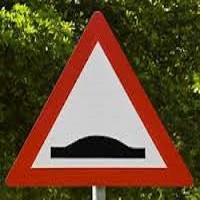Slowly slowly wins the race…
I’m often asked by pupils “what is the best way to drive over a speed bump?” Here are a few things to consider.
The first thing is obviously speed. That’s why they’re called speed bumps. Nobody ever calls them traffic calming measures. This phrase is used to describe all sorts of things that annoy drivers such as chicanes that narrow the lane so only one car can go through at a time. One direction usually has priority and this will be shown by the signs. This can often seem pointless but if people didn’t speed around then these things wouldn’t be here at all.
Take them at a speed below 20mph.This is often the speed limit on roads that have speed bumps anyway. If you take them any quicker than this then you risk damaging your car’s suspension. Make sure you plan ahead and see the signs and bumps well in advance. Some speed bumps are not coloured red but are the same colour as the road surface. The white triangle markings wear off as cars go over them and if it’s wet they can be just about invisible until your car hits them. Especially if you are having driving lessons in the dark. If you’re on a motorbike can be deadly.
When confronted by the square with slanted sides variety of bump that can be straddled by buses then there are a couple of ways to go over them depending on how many people are in the car. If there are two or more then go over them centrally. The tyres will hit the lower slanted bit and you’ll get less of a bump. You’ll also stay in a safe position on the road.
Don’t hurt the driving school car.
If there is just you driving and the passenger seat is empty then check mirrors and move over to the right a bit if the road is clear. The passenger side wheel which has less weight on it will go over the bump and you’ll get less of a jolt. DO NOT swerve in front of oncoming traffic to do this. It’s one of the things which annoys me when I see it being done.
My favourite speed bump is the type that goes all the way across the road. Probably not a favourite of cyclists and motorbike people. You know you can’t avoid it and so everybody slows down properly to go over them. Which is kind of like the whole point. Keep a low even speed on roads with speed bumps. Don’t accelerate and then brake in between each one. You’ll use a lot more fuel and cause wear and tear on the car. It’s not a nice ride for passengers either.
Make sure you have finished braking before you get to the speed bump so the weight isn’t on the front wheel. This will make it a lot smoother. That’s all I have to say on speed bumps.


Just a quick point with regards to the square speed bumps. A few years ago an insurance group investigated why they seemed to be getting a significant number of claims where the inner tyre walls on cars were damaged. They discovered the one thing the drivers had in common was that they frequently drove along roads with the square speed bumps. Because the bumps are slanted, this causes the inner part of the tyres to rub along the surface. However, tyre inner walls are not designed for coming into contact with road surface, which is rough in nature for added grip. They therefore recommended that drivers should put one wheel on the speed bump so the other is on the flat road surface. This is definitely not a comfy ride, but having spoken to someone I know about this, who lives near a road which is half a mile long with these speed bumps along the whole length, and who suffered 2 tyres with damaged inner walls, then I think it’s worth knowing this if you are in a position of having to use such roads often. I have since come across a few places where rubber surrounds have been added to the speed bumps (but that was before the recession took hold!).
I have just found this Telegraph article from 2009: http://www.telegraph.co.uk/motoring/caradvice/honestjohn/6509503/Honest-John-Road-humps-rip-tyre-inner-walls-to-shreds.html
I hope this is useful.
Jackie